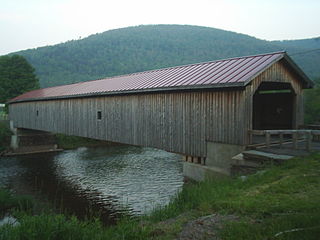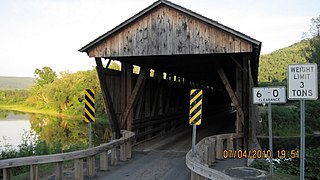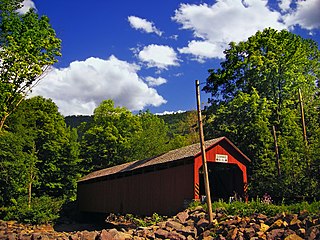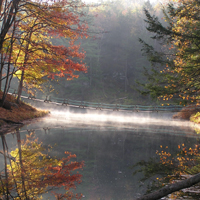
Perrine's Bridge is the second oldest covered bridge in the State of New York, after the Hyde Hall Bridge in East Springfield. Once located in the hamlet called Perrines Bridge between 1850 and 1861. It is located in the modern day town of Esopus-Rosendale, New York just a few hundred feet to the east of Interstate 87 crossing of the Wallkill River in Ulster County, New York. Originally built to aid in the movement of trade between the towns of Rifton and Rosendale, the bridge is about 90 miles north of New York city between mile markers 81 and 82 on the New York State Thruway. In May 1834 the State of New York authorized and provided money ($700) to Ulster county, NY, to build the bridge. In 1835, the bridge was built by Benjamin Wood, the one-lane wooden covered bridge has been closed to vehicular traffic since 1930. The Bridge derives its name from James W. Perrine, a descendant of Daniel Perrin "The Huguenot", who was a tavern keeper that opened an inn on the east side of that future bridge in 1820. Perrine's son was hired each winter as the "snower". He would spread snow the length of the structure so horse-drawn sleighs could cross.

Olivebridge is a hamlet in the town of Olive, Ulster County, New York, United States, within Catskill Park and the Catskill Mountains.

The Wallkill Valley Rail Trail is a 23.7-mile (38.1 km) rail trail and linear park that runs along the former Wallkill Valley Railroad rail corridor in Ulster County, New York, United States. It stretches from Gardiner through New Paltz, Rosendale and Ulster to the Kingston city line, just south of a demolished, concrete Conrail railroad bridge that was located on a team-track siding several blocks south of the also-demolished Kingston New York Central Railroad passenger station. The trail is separated from the Walden–Wallkill Rail Trail by two state prisons in Shawangunk, though there have been plans to bypass these facilities and to connect the Wallkill Valley Rail Trail with other regional rail-trails. The northern section of the trail forms part of the Empire State Trail.

Hamden Bridge is a wooden covered bridge over the West Branch of the Delaware River in the hamlet of Hamden in Delaware County, New York. It was built in 1859, and is a single span, timber and plan framed bridge. It measures 128 feet long and 18 feet wide. A supporting center pier was added in 1940.

Downsville Bridge is a wooden covered bridge over the East Branch of the Delaware River in the hamlet of Downsville in Delaware County, New York. Designed by Scottish immigrant Robert Murray, the bridge was built in 1854, and is a single span, timber and plan framed bridge. The bridge measures 174 feet (53 m) long and 19 feet (5.8 m) wide.

Salisbury Center Bridge is the only covered bridge in Herkimer County, New York State. It was built in 1875, and is a wood frame Burr Truss bridge measuring 42 feet long and 16 feet wide. The bridge has vertical board siding and is topped by a gable roof. The wooden bridge is one of 29 covered bridges in New York State.

Fitch's Bridge is a wooden covered bridge over the West Branch of the Delaware River. It is in the town of Delhi and is one of 24 covered bridges in New York State. It was originally erected in 1870 in the village of Delhi, and moved to its present location in 1885. The single-span, timber bridge measures 106 feet (32 m) long and 20 feet (6.1 m) wide.

The Sonestown Covered Bridge is a covered bridge over Muncy Creek in Davidson Township, Sullivan County, Pennsylvania built around 1850. It is 110 ft (34 m) long and was placed on the National Register of Historic Places (NRHP) in 1980. It is named for the nearby unincorporated village of Sonestown in Davidson Township, and is also known as the Davidson Covered Bridge. It was built to provide access to a grist mill which operated until the early 20th century.

The Ashokan Center (formerly the Ashokan Field Campus, listed on the National Register of Historic Places as the Ashokan Field Campus Historic District, is a 385 acre outdoor education, conference, and retreat center located in the Catskill Mountains of New York. Schools have explored and been inspired by Ashokan's forests, waterfalls, stream-fed ponds, and open meadows since 1967. Music camps, blacksmithing conferences, and retreat groups have called Ashokan home while schools are not in residence. The name Ashokan means "place of many fishes," or "where rushing waters meet" in the Lenape language.

The Roddy Road Covered Bridge is a small, one lane king post wooden covered bridge near Thurmont, Frederick County, Maryland. It crosses Owen's Creek near Thurmont. It is 40 feet long, 16 feet wide, with a 12 foot-8 inch clearance. It was built between 1850 and 1860.

The Paper Mill Village Bridge, also called the Paper Mill Bridge or Bennington Falls Covered Bridge, is a wooden covered bridge that carries Murphy Road across the Walloomsac River northwest of Bennington, Vermont. Built in 1889, it was listed on the National Register of Historic Places in 1973.

The Carlton Bridge is a historic wooden covered bridge that carries Carlton Road over the South Branch Ashuelot River in East Swanzey, New Hampshire. The bridge was built in 1869, and is the region's only surviving example of a 19th-century Queenspost truss bridge. The bridge was listed on the National Register of Historic Places in 1975.

The Bement Covered Bridge is a historic wooden covered bridge on Center Road over the Warner River in Bradford, New Hampshire. A Long-truss bridge, it was built in 1854, and is one of New Hampshire's small number of surviving 19th-century covered bridges. It was listed on the National Register of Historic Places in 1976.

The ChamberlinMill Covered Bridge, also called Chamberlin Covered Bridge or Whitcomb Covered Bridge, is a historic covered bridge that carries Chamberlain Bridge Road across the South Wheelock Branch of the Passumpsic River in Lyndon, Vermont. Built in 1881, it is one of five similar area bridges. It was listed on the National Register of Historic Places in 1974.
Donnelly House is a historic home located at New Lebanon in Columbia County, New York. It was built about 1760 and is a modestly scaled saltbox style residence. It is a two-story, three-bay, center chimney, frame dwelling with narrow siding on a fieldstone foundation. It measures 38 feet, 7 inches wide and 26 feet, 1/2 inch deep. Also on the property are two small barns.

The Covered Bridge in Cedarburg, Ozaukee County, Wisconsin, United States, is one of the last remaining covered bridges in that state, which once had about 40 covered bridges. Built in 1876 to cross Cedar Creek, the bridge is 120 feet (37 m) long and is made of pine with oak lattices. It was listed on the National Register of Historic Places in 1973 and is now used only for pedestrian traffic.
Oliver Avenue Bridge was a historic railroad bridge located at Middletown in Orange County, New York. It was built in 1895 by the Havana Bridge Works. It was a single span, metal trough Pratt truss structure measuring 20 feet wide and 105 feet long. The bridge has been demolished.

Putnam County Bridge No. 159, also known as the Reelsville Bridge, is a historic Open spandrel bridge located in Washington Township, Putnam County, Indiana. It was designed by noted bridge architect Daniel B. Luten and built in 1929, and replaced an earlier truss and covered bridge. It measures 171 feet, 6 inches, long and consists of five reinforced concrete approaches and a 120 feet, 6 inch, open spandrel span at the center.

The New Haven-Weybridge Rattling Bridge is a historic bridge spanning Otter Creek between the Vermont towns of Weybridge and New Haven. It connects Town Highway 7 in New Haven with Town Highway 11 in Weybridge. Built in 1908 by the American Bridge Company, it is a well-preserved example of a rivet-connected lattice truss bridge. It was listed on the National Register of Historic Places as Bridge 26 in 2006.

Bridge 12 is a historic Parker through truss bridge, carrying Boston Post Road across the Missisquoi River in Enosburg, Vermont. Built in 1929 in the wake of Vermont's devastating 1927 floods, it is one a shrinking number of surviving truss bridges on the river. It was listed on the National Register of Historic Places in 2007.






















